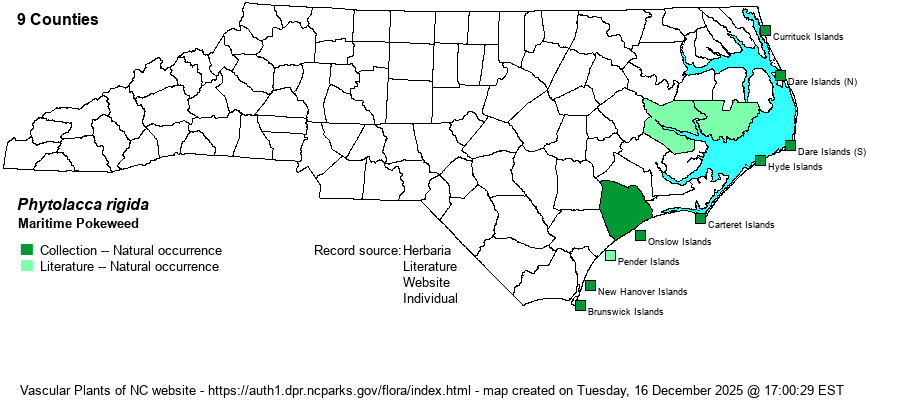| Section 6 » Family Phytolaccaceae |
Show/Hide Synonym
| taxonName | relationship | relatedTaxonName | relatedTaxonRefText | relComments |
|---|
|
|
|
| Phytolacca rigida | < | Phytolacca americana | Godfrey and Wooten (1979, 1981) | | | Phytolacca rigida | < | Phytolacca americana | Radford, Ahles, and Bell (1968) | | | Phytolacca rigida | < | Phytolacca americana | Wunderlin & Hansen Flora of Florida (3) | | | Phytolacca rigida | = | Phytolacca americana var. rigida | Flora of North America (1993b, 1997, 2000, 2002a, 2002b, 2003a, 2004b, 2005, 2006a, 2006b, 2006c, 2007a, 2009, 2010) | | | Phytolacca rigida | = | Phytolacca americana var. rigida | | | | Phytolacca rigida | = | Phytolacca americana var. rigida | | | | Phytolacca rigida | = | Phytolacca americana var. rigida | Flora of Virginia | | | Phytolacca rigida | = | Phytolacca americana var. rigida | Rohwer in Kubitzki, Rohwer, & Bittrich (1993). | | | Source: Weakley's Flora |
|
| Author | Small | |
| Distribution | Scattered throughout the coast from the VA border to the SC border, barely ranging inland to Beaufort and mainland Hyde counties.
This is a Southeastern species of coastal regions. It occurs from southeastern VA to FL and west to TX. | |
| Abundance | Uncommon to infrequent very close to the coast, very rare farther inland. This species was once tracked as Significantly Rare by the NCNHP, but it has since been moved to the Watch List. The website editors suggest a State Rank of S2S3, as it is quite widespread in coastal regions, though still infrequent. Note that NatureServe does not treat it as a full species. | |
| Habitat | This is a distinctly coastal species in the state, in both dry and moist ground. It can grow on dunes and sand flats, along sandy margins of maritime forests and shrub thickets, but also along moist edges of tidal marshes. Rarely it grows on xeric sandhills near the coast. | |
| Phenology | Blooms from May to frost, and fruits in the fall. | |
| Identification | This species is quite similar to P. americana in overall growth form, being robust and to 6-9 feet tall, with a thick stem. The leaves are large, alternate, and often 6 inches long and much narrower. However, in this species the flower clusters -- racemes in leaf axils -- are erect and shorter than on the common species, being about 6-9 cm (averaging about 3 inches) long, as opposed to 10-20 cm (averaging about 6 inches) long in the common species. In the common species, the raceme -- perhaps in being much longer, grows horizontally and then droops in fruit; on the other hand, P. rigida has this raceme erect both in flower and in fruit, rarely divergent. It has dark purple berries, as does the common species. Based on these keys, it seems that -- until the racemes are seen in summer -- you might not be able to determine which species is which along the coast. At any rate, by midsummer into fall, you should be able to identify this uncommon species. | |
| Taxonomic Comments | Most references do not consider this as a good species, instead usually naming it as P. americana var. rigida; NatureServe follows this treatment. Weakley (2018), which this website follows, does treat it as a good species.
| |
| Other Common Name(s) | None? | |
| State Rank | S2 [S2S3] | |
| Global Rank | G5T5 [G5] | |
| State Status | W1 | |
| US Status | | |
| USACE-agcp | | |
| USACE-emp | | |

